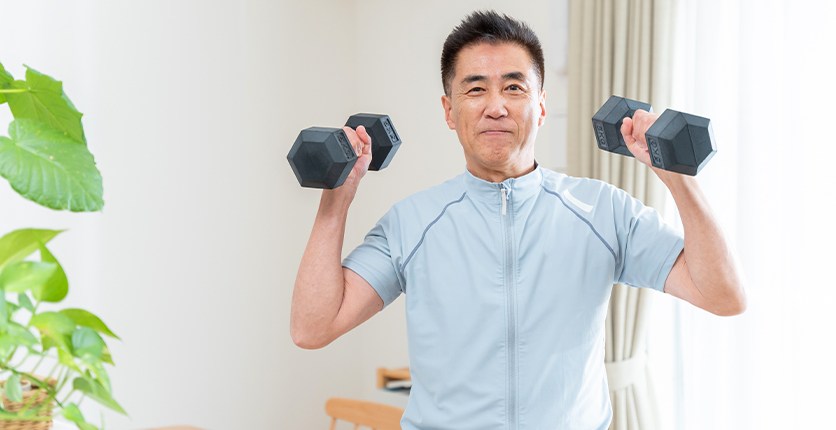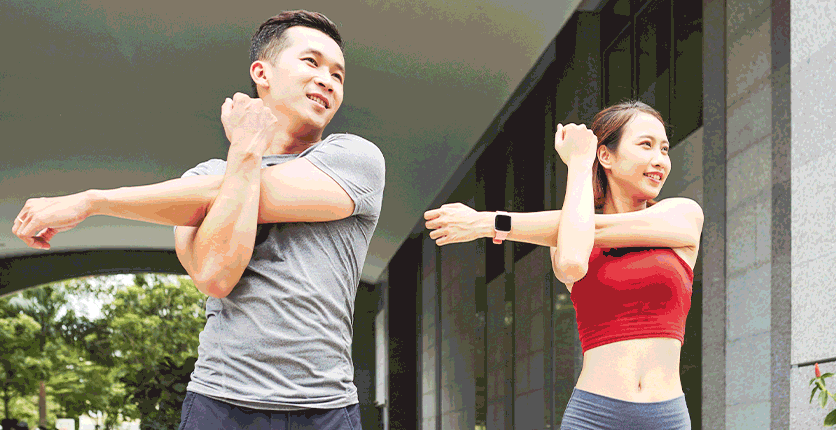Changes start taking place in our body as we start to approach middle age. We may notice that we’re more forgetful or that our eyesight isn’t as good as it used to be; we may even find ourselves needing more rest during the day and our bodies may start to hurt.
“Knee pain, lower back discomfort, and stiffness in the upper back and shoulders are common health concerns among people aged 55 and older,” says Aaron Hor, a physiotherapist at Heartland Rehab, a physiotherapy clinic at SAFRA Choa Chu Kang.
“Studies show that a gradual decline in muscle fibres begins as early as the fifth decade of life, with an annual reduction of approximately one to two per cent, depending on an individual’s level of physical activity.
“The consequent diminished muscle strength may make tasks like walking long distances or performing functional movements, such as climbing stairs and bending down to pick up items, more difficult, painful and uncomfortable in certain parts of the body.”
What can you do to stay fit and strong now, for an effortless transition into middle age? Aaron shares his tips.
1. Exercise for 150 to 300 minutes a week
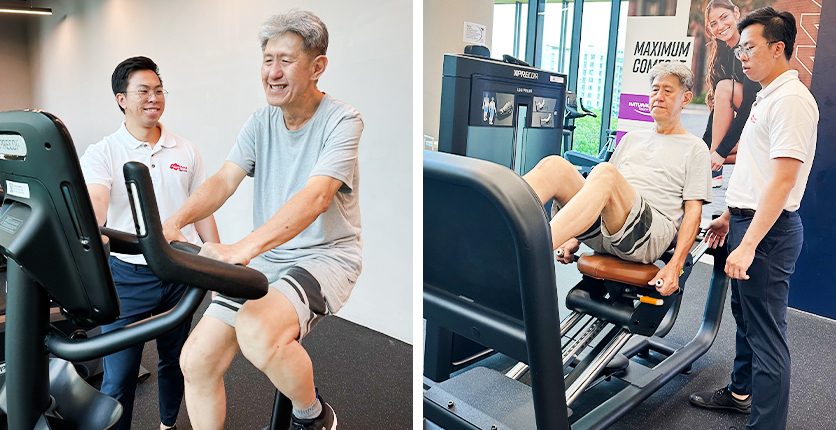
“Regular physical activity plays a crucial role in maintaining and enhancing our health across all stages of life,” says Aaron.
“Evidence indicates that regular physical activity reduces our risk of all-cause mortality, cancer, cardiovascular disease, musculoskeletal issues, metabolic disorders, and cognitive decline. Through exercise, our muscles become stronger and more capable.”
Exercise can be categorised as aerobic/endurance and strength/resistance training. Examples of aerobic activities include walking for extended periods and swimming, while resistance exercises may involve squats and movements using elastic resistance bands.
The Singapore Health Promotion Board recommends a minimum of 150 to 300 minutes of moderate-intensity aerobic physical activity per week. If you have a chronic condition like type 2 diabetes or hypertension, consult a qualified healthcare professional before starting any exercise regimen.
Programmes that incorporate resistance training are particularly vital for combating frailty and sarcopenia (loss of muscle mass) in older individuals, consequently reducing the risk of physical disability and early cognitive decline (known as cognitive frailty), Aaron notes.
It’s important to engage in resistance training activities two or more days per week.
2. Take care of your bones

Osteoporosis is characterised by low bone mineral density (BMD) resulting from changes in bone microstructure, which ultimately increases the risk of low-impact, fragility fractures, says Aaron.
These fractures may lead to a significant decline in quality of life, along with heightened morbidity, mortality and disability.
Risk factors for osteoporosis include inadequate nutritional absorption, a lack of physical activity, weight loss, cigarette smoking, alcohol consumption, air pollution and stress. The use of certain medications, and conditions like vitamin D deficiency, cardiovascular disease and dementia may add to this risk, Aaron continues.
Besides getting regular physical activity, avoiding smoking and alcohol, maintaining a healthy weight, reducing your exposure to air pollution and managing stress, it’s important to follow a nutritious diet. Aaron says that dairy products, fruits and whole grains all positively influence bone health.
A low BMD and the presence of degenerative disc disease are the most significant influences on the progression of kyphosis (a hunched-over posture) over time.
Read more about the health issues to look out for as you hit each age group.
3. Keep your muscles strong
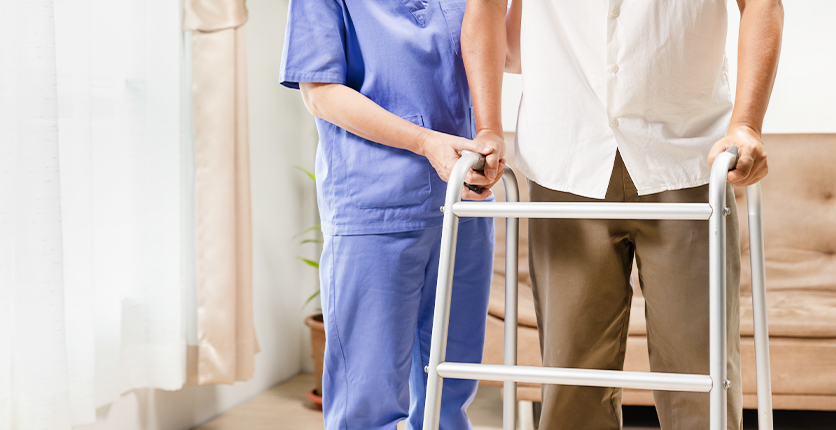
Regular physical activity, eating a healthy diet and getting routine medical check-ups may also help to prevent sarcopenia, which is prevalent among the elderly
“Sarcopenia is a musculoskeletal condition characterised by the gradual decline in muscle mass and strength,” says Aaron.
Diagnosis involves assessing three key aspects: muscle strength, muscle quantity or quality, and physical performance. This progressive loss of musculoskeletal integrity may lead to stamina loss, difficulty performing daily activities, poor balance and a greater risk of falls and fractures, a decrease in muscle size, heightened complication rates post-surgery, and increased mortality and morbidity in major surgical procedures, Aaron adds.
4. Eat a healthy but varied diet

What we eat is important to preventing age-related diseases and maintaining overall good health as we age.
The Singapore Health Promotion Board advocates for a balanced diet, where half our plate comprises fruits and vegetables, a quarter whole grains, and the remaining quarter meat or other protein sources. Aaron points out that this recommendation aligns with recent medical research indicating that nutrients like calcium, phosphorus, magnesium and vitamin D play essential roles in promoting bone health.
At the same time, remember to limit your intake of sugars, saturated fats and processed foods.
5. Maintain a stable weight
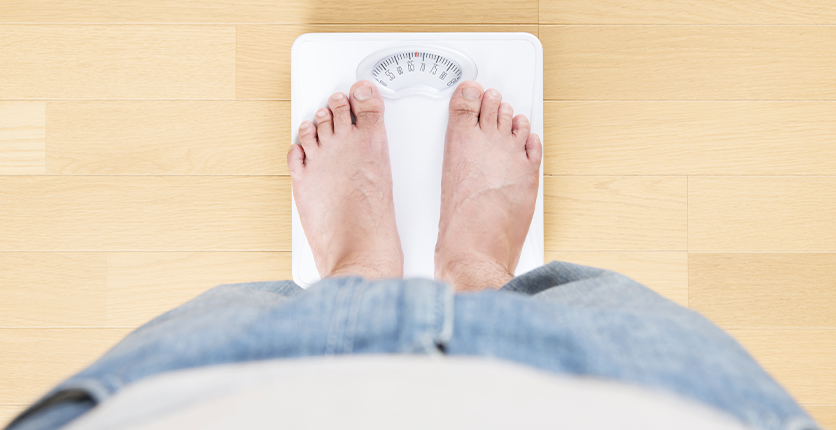
Obesity increases our risk of type 2 diabetes and coronary heart disease and is associated with a greater risk of physical disability. Sadly, more of us are becoming obese as we age; we tend to carry most of this extra fat in our abdomen.
Conversely, being underweight or losing a large amount of weight over a short period isn’t healthy, either.
“It’s crucial to acknowledge the occurrence of sarcopenic obesity, where age-related muscle loss coincides with obesity,” says Aaron.
“It’s also important to note that weight loss induced by dieting can lead to a loss not only of fat but also of muscle and bone mass, potentially exacerbating age-related sarcopenia and frailty in older adults.
“Therefore, a holistic approach combining exercise, both aerobic and resistance training, alongside diet-induced weight loss, is recommended to enhance physical function and mitigate frailty in older adults.
“Older adults are encouraged to maintain a healthy weight within the appropriate body mass index (BMI) ranges to support overall health and well-being.”
Start picking up these healthy habits that help you age well.
6. Restore your body with sleep

“Sleep deprivation is linked to an array of health issues, including poorer mental health, obesity, cancer, diabetes, heart disease, and various other conditions,” Aaron points out.
“People with musculoskeletal conditions and chronic pain are particularly susceptible to sleep deprivation, exacerbating their health challenges. Poor sleep not only impacts our general health but also directly affects inflammation, pain response and overall well-being.”
Sleep is widely recognised as a crucial component of recovery, playing a restorative role in the immune and endocrine systems, enhancing mood, and improving attention.
“The National Sleep Foundation has established guidelines for recommended sleep durations: eight to 10 hours for adolescents, seven to nine hours for adults and seven to eight hours for older adults,” Aaron continues.
“Adhering to these guidelines can significantly contribute to your overall health and well-being. Enjoying quality sleep therefore helps to prevent health issues and allows for better mood and recovery.”
SAFRA members enjoy up to 15% discount and priority booking at Heartland Rehab. For more info, go to safra.sg/lifestyle/heartland-rehab
Want more articles like this, and other lifestyle content right in your inbox? Download the new SAFRA mobile app and opt in for the eNSman Newsletter – you don’t need to be a SAFRA member to subscribe – and never miss another story!
